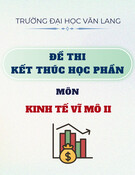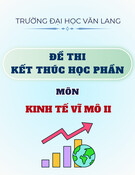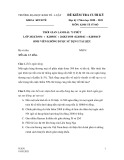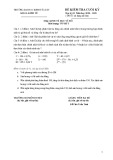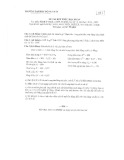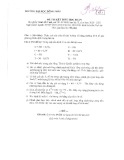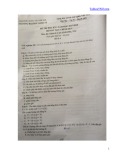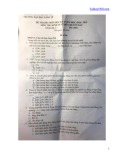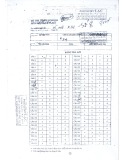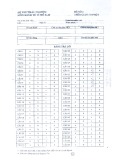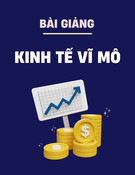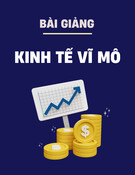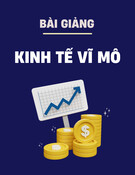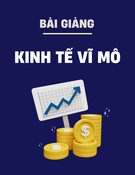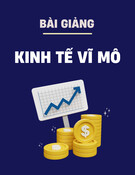
BM-003
TRƯỜNG ĐẠI HỌC VĂN LANG
KHOA: QUẢN TRỊ KINH DOANH
ĐỀ THI VÀ ĐÁP ÁN ĐỀ THI KẾT THÚC HỌC PHẦN
Học kỳ 3 , năm học 2021 - 2022
Mã học phần: 72ECON20033
Tên học phần: Macroeconomics
Mã nhóm lớp học phần: 213_72ECON20033_01
Thời gian làm bài (phút/ngày): 90 phút
Hình thức thi: Trắc nghiệm kết hợp tự luận
Cách thức nộp bài phần tự luận (Giảng viên ghi rõ yêu cầu):
Gợi ý:
- SV gõ trực tiếp trên khung trả lời của hệ thống thi;
- Upload file bài làm (word, excel, pdf…);
- Upload hình ảnh bài làm (chỉ những trường hợp vẽ biểu đồ, công thức tính toán đặc biệt).
PHẦN TRẮC NGHIỆM (6 điểm)
The amount of unemployment that an economy normally experiences is called the
A. natural rate of unemployment.
B. average rate of unemployment.
C. cyclical rate of unemployment.
D. typical rate of unemployment.
ANSWER: A
The Bureau of Labor Statistics counts a member of a surveyed household as an adult if that
person is at least
A. 16 years old.
B. 14 years old.
C. 18 years old.
D. 21 years old.
ANSWER: A
Cyclical unemployment refers to
A. year-to-year fluctuations of unemployment around its natural rate.
B. how often a worker is likely to be employed during her lifetime.
C. the relationship between the probability of unemployment and a worker's changing level
of experience.
D. long-term trends in unemployment.
1

ANSWER: A
In the long run the unemployment rate equals
A. the natural rate of unemployment.
B. the cyclical rate of unemployment.
C. zero.
D. the sum of the cyclical and natural rate of unemployment.
ANSWER: A
Who in the adult population is counted as “employed” in U.S. labor statistics?
A. people who are temporarily absent from their job and people who work without pay in a
family member’s business
B. people who are temporarily absent from their job but not people who work without pay
in a family member’s business
C. people who work without pay in a family member’s business but not people who are
temporarily absent from their job
D. neither people who are temporarily absent from their job nor people who work without
pay in a family member’s business
ANSWER: A
Which of the following is not correct?
A. When unions raise wages above equilibrium, the quantity of labor supplied decreases,
and the quantity of labor demanded increases.
B. Like any cartel, a union is a group of sellers acting together in the hope of exerting their
joint market power.
C. When a union is present in a labor market, wages may not be determined by the
equilibrium of supply and demand.
D. Most workers in the U.S. economy are not members of a union.
ANSWER: A
Esmerelda worked part-time for her mother’s business without pay. Tabitha was absent
from work because she had strep throat. Who is counted as “employed” by the Bureau of
Labor Statistics?
A. both Esmerelda and Tabitha
B. Tabitha but not Esmerelda
C. Esmerelda but not Tabitha
D. neither Esmerelda nor Tabitha
ANSWER: A
The invention of the telegraph led to the loss of jobs for those who had delivered mail by
horse but created jobs for telegraph operators and delivery persons. This is an example of
A. frictional unemployment created by sectoral shifts.
B. structural unemployment created by sectoral shifts.
C. frictional unemployment created by efficiency wages.
D. structural unemployment created by efficiency wages.
ANSWER: A
Wages in excess of their equilibrium level help explain
A. both structural unemployment and the natural rate of unemployment.
B. the natural rate of unemployment but not structural unemployment.
C. structural unemployment but not the natural rate of unemployment.
D. neither structural unemployment nor the natural rate of unemployment.
ANSWER: A
Which type(s) of economies interact with other economies?

BM-003
A. only open economies
B. only closed economies
C. closed economies and open economies
D. neither closed nor open economies
ANSWER: A
When Jamie, a U.S. citizen, purchases a wool jacket made in Ireland, the purchase is
A. a U.S. import and an Irish export.
B. both a U.S. and Irish import.
C. a U.S. export and an Irish import.
D. neither an export nor an import for either country.
ANSWER: A
A farmer in Mexico purchases a tractor made in the U.S. This purchase is an example of
A. a U.S. export and a Mexican import
B. a U.S. import and a Mexican export
C. an export for both the U.S. and Mexico
D. an import for both Mexico and the U.S.
ANSWER: A
If Norway sold more goods and services abroad than it purchased from abroad, then it had
A. positive net exports which is a trade surplus.
B. positive net exports which is a trade deficit.
C. negative net exports which is a trade surplus.
D. negative net exports which is a trade deficit.
ANSWER: A
If the U.S. has exports of $1.5 trillion and imports of $2.2 trillion, then the U.S.
A. buys more from overseas then it sells overseas; it has a trade deficit.
B. sells more overseas then it buys from overseas; it has a trade surplus.
C. sells more overseas then it buys from overseas; it has a trade deficit.
D. buys more from overseas then it sells overseas; it has a trade surplus.
ANSWER: A
If the exchange rate is 2 Brazilian reals per dollar and a meal in Rio costs 20 reals, then
how many dollars does it take to buy a meal in Rio?
A. 10 and your purchase will increase Brazil’s net exports.
B. 40 and your purchase will increase Brazil’s net exports.
C. 40 and your purchase will decrease Brazil’s net exports.
D. 10 and your purchase will decrease Brazil’s net exports.
ANSWER: A
Suppose the world had only two countries and domestic residents of country A purchased
$50 billion of assets from country B and country B purchased $30 billion of assets from
country A. What would the net capital outflows of both countries be?
A. $20 billion for country A and -$20 billion for country B
B. $30 billion for country A and $50 billion for country B
C. $50 billion for country A and $30 billion for country B
D. -$20 billion for country A and $20 billion for country B
ANSWER: A
In Ireland, a pint of beer costs 3 euros. In Australia, a pint of beer costs 4 Australian
dollars. If the exchange rate is .8 euros per Australian dollar, what is the real exchange
rate?
A. 3.2/3 pints of Irish beer per pint of Australian beer
3

B. 3/3.2 pint of Irish beer per pint of Australian beer
C. 4/2.4 pints of Irish beer per pint of Australian beer
D. 2.4/4 pints of Irish beer per pint of Australian beer
ANSWER: A
According to purchasing-power parity, if the same basket of goods costs $100 in the U.S.
and 50 pounds in Britain, then what is the nominal exchange rate?
A. 1/2 pound per dollar
B. 1 pound per dollar
C. 2 pounds per dollar
D. 2.5 pounds per dollar
ANSWER: A
A relatively mild period of falling incomes and rising unemployment is called a(n)
A. recession.
B. depression.
C. expansion.
D. business cycle.
ANSWER: A
Most economists use the aggregate demand and aggregate supply model primarily to
analyze
A. short-run fluctuations in the economy.
B. the effects of macroeconomic policy on the prices of individual goods.
C. the long-run effects of international trade policies.
D. productivity and economic growth.
ANSWER: A
Which of the following is most commonly used to monitor short-run changes in economic
activity?
A. real GDP.
B. the inflation rate.
C. interest rates.
D. value of the U.S. dollar in the foreign exchange market.
ANSWER: A
During recessions investment
A. falls by a larger percentage than GDP.
B. falls by about the same percentage as GDP.
C. falls by a smaller percentage than GDP.
D. falls but the percentage change is sometimes much larger and sometimes much smaller.
ANSWER: A
Other things the same, an increase in the price level makes the dollars people hold worth
A. less, so they can buy less.
B. more, so they can buy less.
C. less, so they can buy more.
D. more, so they can buy more.
ANSWER: A
Which of the following rises when the U.S. price level falls?
A. real wealth
B. the value of the dollar in the market for foreign-currency exchange
C. interest rates
D. real GDP

BM-003
ANSWER: A
The aggregate quantity of goods and services demanded changes as the price level rises
because
A. real wealth falls, interest rates rise, and the dollar appreciates.
B. real wealth falls, interest rates rise, and the dollar depreciates.
C. real wealth rises, interest rates fall, and the dollar appreciates.
D. real wealth rises, interest rates fall, and the dollar depreciates.
ANSWER: A
Other things the same, if the price level is lower than expected, then some firms believe
that the relative price of what they produce has
A. decreased, so they decrease production.
B. decreased, so they increase production.
C. increased, so they increase production.
D. increased, so they decrease production.
ANSWER: A
The price level rises in the short run if
A. aggregate demand shifts right or aggregate supply shifts left.
B. aggregate demand or aggregate supply shifts right.
C. aggregate demand shifts left or aggregate supply shifts right.
D. aggregate demand or aggregate supply shifts right.
ANSWER: A
Shifts in the aggregate-demand curve can cause fluctuations in
A. the level of output and in the level of prices.
B. the level of output, but not in the level of prices.
C. the level of prices, but not in the level of output.
D. neither the level of output nor the level of prices.
ANSWER: A
Monetary policy and fiscal policy influence
A. output in the short run only.
B. output and prices in the short run only.
C. output in the short run and the long run.
D. output and prices in the short run and the long run.
ANSWER: A
The interest-rate effect
A. is the most important reason, in the case of the United States, for the downward slope of
the aggregate-demand curve.
B. depends on the idea that increases in interest rates increase the quantity of money
supplied.
C. depends on the idea that increases in interest rates increase the quantity of money
demanded.
D. is the least important reason, in the case of the United States, for the downward slope of
the aggregate-demand curve.
ANSWER: A
The idea that a decrease in the price level raises the real value of households’ money
holdings, which increases consumer spending and the quantity of goods and services
demanded is known as
A. the wealth effect.
B. the exchange-rate effect.
5

